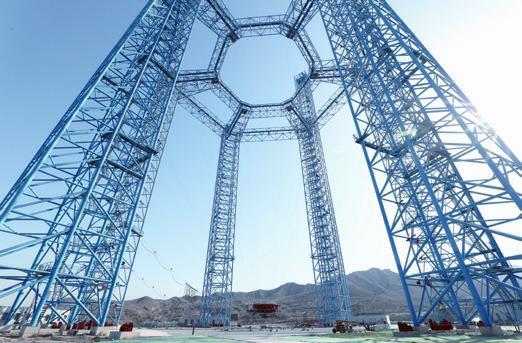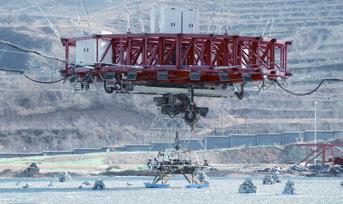Closer to the Red Planet
2020-05-11ByWangHairong
By Wang Hairong

Huailai, a county in Hebei Province bordering Beijing, has gained a place in Chinas aerospace history after Asias largest test site for landing on extraterrestrial bodies was built there last year.
Six gigantic steel-woven columns, towering more than 100 meters above the ground and joined at the top by one big hexagon with a smaller one embedded within, stand as physical evidence to Chinas looming Mars mission. Planned for launch later this year, the countrys fi rst Mars probe has been carrying out landing drills in Huailai since last November.
On Chinas Space Day on April 24, the China National Space Administration (CNSA) announced that the mission was given the name Tianwen-1. Chosen from some 35,000 entries collected via an international poll since 2016, the name literally means “ask the sky.” It was inspired by a poem by great poet Qu Yuan (340- 278 B.C.), and was picked to signify the Chinese nations perseverance in pursuing truth and science, and exploring nature and the universe.
The CNSA also declared that the Tianwen program will include all of the countrys future planetary exploration missions, and unveiled its logo featuring the letter C, standing for China, international cooperation and capacity for going into space.
The upcoming mission
As one of our neighbors in the solar system, Mars, half the size of Earth, has long fascinated Earth dwellers. It bears some similarities to our home planet such as a solid surface, though arid and rocky, and a thin atmosphere. Its day is about the same length as ours, and its year twice as long. It also has seasons, though its overall temperature is much lower. Evidence of frozen water and even seasonal liquid water found on Mars by scientists in recent years have piqued intense curiosity about the possibility of the existence of life forms.
Due to planetary alignment, Mars is closest to Earth once every 26 months, offering an optimal time to land a probe. For this reason, Chinas Mars probe has been scheduled for this July, Li Guoping, Director of the Department of System Engineering of the CNSA, said at a subforum of the World Conference on Science Literacy held in Beijing in September 2018.
Chinas fi rst Mars exploration will be tasked with orbiting, landing and roving the planet, according to Ge Xiaochun, the CNSAs chief engineer.
The travel time to Mars will be about seven months, said Zhang Rongqiao, chief architect of the Mars exploration program. “Our fi rst mission will feature two vehicles, an orbiter to circle around Mars and a rover to cruise upon the planet,” Zhang recently told The Beijing News, adding that the former will carry seven scientifi c payloads and the latter six. The equipment will take photos, measure Martian elements, monitor the environment and study its geological structure and weather.
Preparations underway
The successful completion of several lunar probe missions in recent years has paved the way for Chinas Mars mission, which was officially approved in 2016. Yet since Mars is at least 55 million km and at most 300-400 million km from Earth, the journey is much more challenging than that to the Moon, which is about 380,000 km on average away.
Thus, a powerful launch vehicle is needed to cover the distance. The Long March-5 rocket, Chinas largest carrier rocket, will be used for the mission, Wu Yanhua, Deputy Administrator of the CNSA, told China Global Television Network(CGTN) after the successful launch of a rocket of this type in December 2019.
The mission also requires advanced orbit design, flight control, communication, power supply and other technologies, said Pang Zhihao, a researcher with the China Academy of Space Technology, in a widely-circulated article published in 2018. “The diffi culty of getting into a Mars orbit is like hitting a golf ball from Paris into a hole in Tokyo,” he wrote. He said only half of the more than 40 Mars probe missions launched from Earth so far have been successful.

Moreover, landing on Mars usually takes only about seven minutes, and is a complicated process that requires a high degree of accuracy, Pang said. Probes entering the Mars orbit incorrectly may either miss the planet or collide with it, he added. Furthermore, because there is a delay in communication signals, data for landing has to be put in the probe in advance, Pang said. This poses another whole set of risks.
Another big threat comes from Martian dust sandstorms, which can block the sunlight and make solar panels of the rovers ineffective. Dust storms on Mars are extremely massive and can last up to half a year, with winds that can sometimes be six times as powerful as the strongest typhoon on Earth, Pang said.
In November 2019, the first simulated landing for Chinas Mars probe was carried out in Huailai in front of an international audience, which demonstrated the spacecrafts capability to hover above and then descend onto the planet. Ambassadors and other diplomats from 19 countries were invited to observe the experiment. The steel-woven structure described above was constructed to mimic Martian gravity, which is about one third of that of Earth.
In addition, since the long distance between Earth and Mars means weak communication signals, there is a need for more advanced technologies. On March 10, Chinese scientists and engineers completed the first wireless communication and connection test for the Mars mission, according to the Beijing Aerospace Control Center. It verifi ed the signal transmission and interface compatibility between the ground system and the Mars probe, as well as other hardware and software involved.
On April 25, a large-aperture antenna was installed in Wuqing District in Tianjin, north China. It will work with two existing antennas respectively in Miyun District in Beijing and Kunming, capital of Yunnan Province in the southwest, to receive data from Mars.
“The signal from Mars is so attenuated that without this large-aperture antenna, the task cannot be accomplished,” Li Chunlai, deputy chief designer of the Mars mission, told CGTN.
Mars probing is an important part of Chinas deep space exploration. In recent decades, this exploration has yielded many important discoveries, which have greatly enriched humanitys understanding of the universe, especially the solar system.
Over the past more than 50 years, the United States, Russia, the European Space Agency, India and Japan have carried out Mars exploration activities, Zhang said. In this context, it is necessary for Chinese scientists to get a clear understanding of what has been proven, and determine what original researches still need to be made, Zhang told Beijing-based Guangming Daily.
Although Chinas Mars exploration has gotten a late start, it also has a relatively clearer goal, he said, adding that the country plans to complete a “two-step” Mars exploration by around 2030. The fi rst step is to orbit, land on and rove the planet, while the second step is to bring Martian samples back to Earth.

